Higher Education Quality Monitoring and Evaluation in China
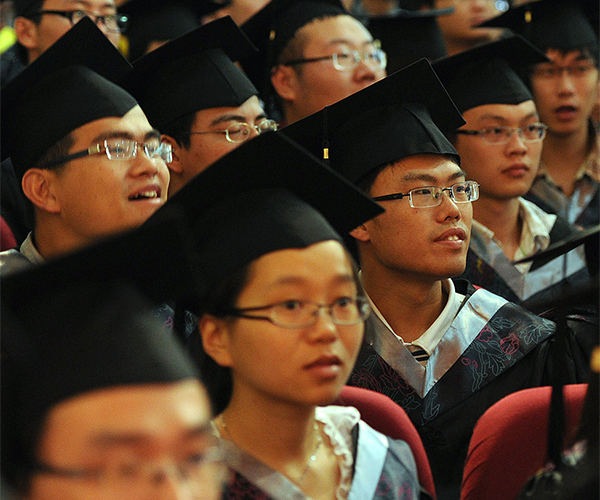
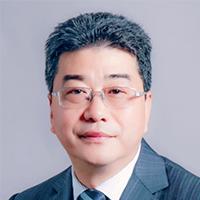
Prof. Dr. Wu Yan is Director General of the Higher Education Evaluation Center (HEEC) of the Ministry of Education, P.R.China. He graduated from Xiamen University with a Ph.D. in Education, and is currently employed as Professor and Ph.D. Supervisor at Beijing University of Aeronautics and Astronautics, Tsinghua University, Xiamen University and Tongji University. Before his appointment as Director General of HEEC in 2013, Prof. Dr. Wu Yan was President of Beijing Institute of Educational Science. Concurrently, he serves as Vice Chair and Secretary General of the China Engineering Education Accreditation Association (CEEAA) and President of the Industry- University-Research Cooperation Subcommittee of the China Association of Higher Education.
Prof. Dr. Wu Yan has long been engaged in the study and practices in educational strategy, higher education and quality assurance. He published over 50 research papers and several books on these fields including New Visions of International Quality Assurance in Higher Education, Power of Higher Education: China Dream & the Way toward It, Setting up High Education Quality Assurance System with Chinese Characteristics, etc. Since 2014 he has been Editor-in-Chief of the Series of National Higher Education Reports of China. Prof. Dr. Wu Yan is a “State Council Expert for Special Allowance,” and the Project Team Leader of the State- Level Key Research Project in Education—The Establishment and Development of “Student-Сentered” Quality Assurance System in HEIs.
Overview of Higher Education Development
With a total of 2,880 different level colleges and universities, 36.99 million higher education students and a gross higher education enrollment rate of 42.7%, China had established the largest higher education system in the world by the end of 2016. China has witnessed a leap-forward development in higher education and doubled and redoubled increase in “hard indicators.” The quality of higher education is a major driving force to enhance national competitiveness, social development and well-being. Quality assurance has become one of the most important reform areas in higher education policy. Along with the expanding access and massification of higher education in China, the government attached more and more importance to ensuring educational standards and quality. The Outline of China’s National Plan for Medium & Long-Term Education Reform and Development (2010-2020) issued in July 2010 is an important symbol of that. At present, China is entering a quality-centered development stage focusing on quality assurance and improvement. Improving quality, instead of scale expansion, has become the vital task of China’s higher education development.
Features of quality assurance in China
Philosophy
Three philosophies with international substantial equivalence are adopted, including “Student- Centered,” “Outcome-Based Education (OBE)” and “Continuous Quality Improvement (CQI).” It aims at increasing the responsibility and autonomy of HEIs in the QA system, and clarifies that the students’ experiences and development are the priorities in assessment of the institutional or program quality.
Criteria
The Criteria of “Five Level” are adopted, which stands for:
- the Level of “Fitness for Educational Purposes”
- the Level of “Responsiveness to Public Demands”
- the Level of “Supportability of Faculty & Educational Resources”
- the Level of “Effectiveness of Quality Assurance System”
- the Level of “Satisfaction of Students and Employers”
It aims at facilitating the student’s development in an all-around way, increasing the employability and meeting the social demand; putting more emphasis on student learning outcomes, not only the knowledge, but also the skills, competencies, values, ethics; putting more emphasis on graduates’ tracer studies and employer satisfaction survey, beyond the input and process control.
Methodology
The innovative methodology features a combination of periodic evaluation and regular quality monitoring. The former is the internationally recognized mainstream approach to quality assurance, reliance on professional judgment, including multiple patterns, multiple levels and multiple stakeholders involved. The latter is reliance on quantitative assessment via National Data Platform, and is more objective and data and evidence-based. Based on regular quality monitoring, various types of quality reports have been published, including National Quality Report on Higher Education (full coverage report for all regular HEIs), National Quality Report on Engineering Education, National Quality Monitoring Report on Undergraduate Education of Newly-built HEIs, National Quality Report on Undergraduate Teaching, National Quality Report on Private HEIs, etc.
Culture
Measures are taken to foster a quality culture within higher education sectors: enhance the awareness and responsibility of HEIs in quality assurance, and make quality improvement in the inner motivation; promote HEIs to build an internal quality assurance (IQA) system and a long-term effective mechanism, and to foster a quality culture with clear objectives, implementation approaches and quality management; increase the HEIs’ awareness of self-study, self-analysis, self-assessment and self-monitoring.
The implementation and effectiveness of the quality assurance system in China
The government enhances policy and system guarantee and builds a new pattern for quality assurance and public governance. For long, the Chinese government has made efforts to build a quality assurance system for higher education. After entry to the 21st century, the government has taken a series of measures in terms of policies and regulations, quality projects, monitoring and evaluation, given strong support to the reform and development of higher education and assurance for improvement of higher education quality.
1) The government has taken a series of administrative measures to provide basic guarantee for higher education quality
First of all, it deals with enhancing administration by law and controlling the majors set by HEIs. Since the beginning of the 1980s, in order to guarantee education quality, the state has issued and implemented a series of important rules and regulations, such as Interim Regulations on the Setting of Regular HEIs (1986), Criteria for Setting of Higher Vocational Colleges (Interim) (2000), Measures on Setting and Administration of Independent Colleges (2008) which specified the most fundamental criteria for setting up HEIs, Provisions on Setting of Undergraduate Majors at HEIs (1999) which specified the fundamental criteria for major setting up at HEIs, Regulations of the People’s Republic of China on Academic Degrees (1980), and Interim Measures for Implementation of the Regulations of the People’s Republic of China on Academic Degrees (1981) which stipulated the standards for awarding academic degrees.
Since the implementation of the Outline of China’s National Education Plan, the Ministry of Education (MoE) has accelerated the formulation, approval and implementation of articles for HEIs, and formulated the Catalogue of Undergraduate Majors for Regular HEIs (2012), Regulations on the Setting and Administration of Undergraduate Majors of Regular HEIs, Measures on Construction of HEIs Directly under the Administration of Ministry of Education, and Opinions on the Setting of HEIs During the 12th Five-Year Plan, by which more rigorous access standards for HEI setting, major setting and basic construction of HEIs guarantee the compliance with basic quality standards for talent training.
Substantial achievements have been made in the building of high-level HEIs and discipline development due to the implementation of national strategies. In the 1990s, the Chinese government initiated Project 985 aiming to build world-class and high-level universities as well as Project 211 aiming to build about 100 universities and a batch of key disciplines. By 2015 the government had invested special funds of RMB 90.4 billion yuan (approx. USD 14.6 billion) in Project 985 and RMB 18 billion yuan (approx. USD 2.9 billion) in Project 211 and basically fulfilled the phased construction tasks and achieved significant effect. Another example is, the Ministry of Finance allocated special funds of central finance of about RMB 4 billion yuan (approx. USD 64 million) to the Key Characteristic Discipline Program from 2010 to 2015, within which 14 Class I national key disciplines as well as 115 Class II national key disciplines were incorporated into construction. In the recent years the program of building 100 demonstrative higher vocational colleges has also been launched. Through the implementation of these programs, significant improvements have been made in the overall strength of teaching, research and service of higher education.
Since 2000 China has organized the construction of the Chinese National Engineering Research Center, the National Engineering Laboratory, the Key Laboratory of the Ministry of Education, the Engineering Research Center of the Ministry of Education as well as the Key Research Base of Humanities and Social Sciences, etc., forming a demonstrative battlefield in which high-level scientific research is applied to training high-quality talents. In 2014 the Ministry of Education launched 2011 Program and built 80 collaborative innovation centers. Based on the principles of “urgently needed by the state, striving to be world-class” and with the improvement of creative capability integrating talents, disciplines and scientific research, these centers vigorously promoted the collaboration between HEIs, research institutes, industries, enterprises, local governments and the international community, gave support to training of high-quality talents with high-level scientific research and improved educational quality and standards on the whole.

The Memorandum of Understanding between the Higher Education Evaluation Center (HEEC, China) and the National Centre for Public Accriditation (NCPA, Russia).
By enhancing policy guidance great achievements have been made in the Undergraduate Teaching Project. Since the entry to the new century, especially during the Twelfth Five-Year, in order to fully improve the quality of higher education, the National Development and Reform Commission, the Ministry of Finance, the Chinese Academy of Sciences (CAS), other relevant ministries, commissions and industry authorities have cooperated with the MoE to issue a series of policy documents including the Program for Revitalization of Higher Education in the Middle and West Regions, the Plan of Collaborative Talent Training by Combining Science and Education and five Excellent Talent Training Plans so as to practically enhance comprehensive planning and policy guidance.
In 2007 focusing on the improvement of talent training quality the Chinese government initiated the Undergraduate Education Quality and Reform Project of HEIs (hereinafter referred to as the “Quality Project”), which highlighted program quality standard development, comprehensive reform and practice of programs, practical teaching building and student creativity training, curriculum building, teachers’ capacity building, etc. The Ministry of Education and the Ministry of Finance have implemented the Higher Education Teaching Reform Project in the New Century, Education Quality and Reform Project of HEIs and Undergraduate Teaching Project. Within these projects HEIs have carried out in-depth reform and construction, launched teaching reform featuring the widest coverage, the longest duration and most benefits and achieved a series of expected results.
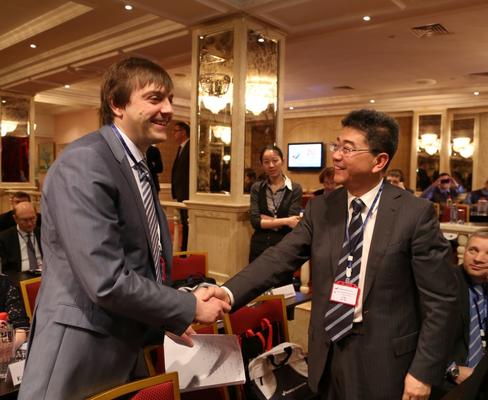
The Memorandum of Understanding between the Higher Education Evaluation Center (HEEC, China) and the Federal Service for Supervision in Education and Science (Rosobrnadzor, Russia).
In terms of quality standard development, the national standards for education quality of 92 undergraduate majors have been basically completed; in terms of comprehensive program reform, 1500 majors have been prioritized to guide HEIs to actively respond to the national strategic demand and local social and economic development demands; in terms of practical innovation ability training, 100 experimental teaching demonstration centers, 1,000 national off-campus practice education bases for college students, 50,000 creativity and entrepreneurship training projects have been built. Also, 30 national teaching development demonstration centers were established in a focused way to guide and assist national HEIs to build teaching development centers that conform to their characteristics. Also, information technology means were fully applied to present 1,000 quality public courses and 5,000 quality resources sharing courses, and to promote the opening of higher education.
With the establishment of periodic evaluation system, various types of monitoring and evaluation contribute to quality improvement. Evaluation is an important means for the government to implement quality assurance system of higher education. Since the 1980s China’s higher education evaluation has evolved from pilot exploration, full implementation to improvement and development, and five large-scale formal evaluations have been carried out. Especially, to “build an education quality evaluation and consulting organization to implement the education quality evaluation system for national HEIs with a cycle of five years” is proposed in the Education Revitalization Program (2003-2007). In August 2004 the Higher Education Evaluation Center of the Ministry of Education (HEEC) was formally established, which marked the specialization of China’s higher education evaluation.
In the first round of periodic undergraduate teaching evaluation from 2003 to 2008, HEEC evaluated 589 HEIs and played a leading role in guiding HEIs to enhance teaching input, regulate teaching management, guarantee teaching orders and refine school-running characteristics. Promoted by external evaluation HEIs continuously made self-evaluation, promptly understood national community, gave support to training of high-quality talents with high-level scientific research and improved educational quality and standards on the whole.
By enhancing policy guidance great achievements have been made in the Undergraduate Teaching Project. Since the entry to the new century, especially during the Twelfth Five-Year, in order to fully improve the quality of higher education, the National Development and Reform Commission, the Ministry of Finance, the Chinese Academy of Sciences (CAS), other relevant ministries, commissions and industry authorities have cooperated with the MoE to issue a series of policy documents including the Program for Revitalization of Higher Education in the Middle and West Regions, the Plan of Collaborative Talent Training by Combining Science and Education and five Excellent Talent Training Plans so as to practically enhance comprehensive planning and policy guidance.
In 2007 focusing on the improvement of talent training quality the Chinese government initiated the Undergraduate Education Quality and Reform Project of HEIs (hereinafter referred to as the “Quality Project”), which highlighted program quality standard development, comprehensive reform and practice of programs, practical teaching building and student creativity training, curriculum building, teachers’ capacity building, etc. The Ministry of Education and the Ministry of Finance have implemented the Higher Education Teaching Reform Project in the New Century, Education Quality and Reform Project of HEIs and Undergraduate Teaching Project. Within these projects HEIs have carried out in-depth reform and construction, launched teaching reform featuring the widest coverage, the longest duration and most benefits and achieved a series of expected results.
In terms of quality standard development, the national standards for education quality of 92 undergraduate majors have been basically completed; in terms of comprehensive program reform, 1500 majors have been prioritized to guide HEIs to actively respond to the national strategic demand and local social and economic development demands; in terms of practical innovation ability training, 100 experimental teaching demonstration centers, 1,000 national off-campus practice education bases for college students, 50,000 creativity and entrepreneurship training projects have been built. Also, 30 national teaching development demonstration centers were established in a focused way to guide and assist national HEIs to build teaching development centers that conform to their characteristics. Also, information technology means were fully applied to present 1,000 quality public courses and 5,000 quality resources sharing courses, and to promote the opening of higher education.
With the establishment of periodic evaluation system, various types of monitoring and evaluation contribute to quality improvement. Evaluation is an important means for the government to implement quality assurance system of higher education. Since the 1980s China’s higher education evaluation has evolved from pilot exploration, full implementation to improvement and development, and five large-scale formal evaluations have been carried out. Especially, to “build an education quality evaluation and consulting organization to implement the education quality evaluation system for national HEIs with a cycle of five years” is proposed in the Education Revitalization Program (2003-2007). In August 2004 the Higher Education Evaluation Center of the Ministry of Education (HEEC) was formally established, which marked the specialization of China’s higher education evaluation.
In the first round of periodic undergraduate teaching evaluation from 2003 to 2008, HEEC evaluated 589 HEIs and played a leading role in guiding HEIs to enhance teaching input, regu late teaching management, gua rantee teaching orders and refine school-running characte ristics. Promoted by external evaluation HEIs continuously made self-evaluation, promptly understood the quality of their talent training and built a long-term mechanism including self-inspection, self-rectification and self-improvement. Currently, the higher education evaluation facilitated by the MoE mainly includes academic degree and post graduate education evaluation, under-graduate education evaluation of HEIs and higher vocational college talents training evaluation. Over nearly 30 years of practice, China has built up a regulated, scientific, systematic and professional higher education evaluation system.
2) Promoting in-depth detachment of governance, school-running and evaluation, creating a new pattern for public governance of higher education quality
The quality assurance of higher education depends on a feasible and effective higher education governance structure. Since the issue of the Outline, focusing on the core of building new relationship among governments, universities and HEIs, the Chinese government has regarded administration, management and evaluation as National systems of accreditation management and evaluation as basic requirements and strived to build a new pattern of quality assurance for higher education featuring governments macro guidance, independent management of HEIs and participation by various social entities.
The government shifts its functions, simplifies procedures and releases power. It is proposed in the Outline to “separate politics from HEIs, administration from management.” It requires to “specify the responsibilities of governments at different levels, regulate the running of HEIs, pro-mote detachment of administration, management and evaluation and build an education management system featuring separation of administrative units and public institutions, clear division of rights and responsibilities, comprehensive coordination and orderly regulation.” The orientation of education management system reform was further specified in the Third Plenary Session of the 18th CPC Central Committee to “further promote the detachment of administration, management and evaluation, increase the education overall planning power and independent running power of provincial governments and perfect the internal governance structure of HEIs.” According to the requirements of the central government on higher education management system reform, in May 2014 the Ministry of Education issued the Plan of Transformation of the Ministry of Education’s Functions. In the Plan, the MoE cancelled 22 of its responsibilities, allocated 13 responsibilities to provincial edu cation administrations, HEIs and organizations directly under the MoE, transferred and authorized 50 responsibilities to the public institutions, organizations and associations directly under its administration, simplified or reduced 23 review items, arranged the responsibilities of nine aspects including basic education management, enhanced and improved three aspects of macro management including education and supervision, and simplified deliberation and coordination agencies.
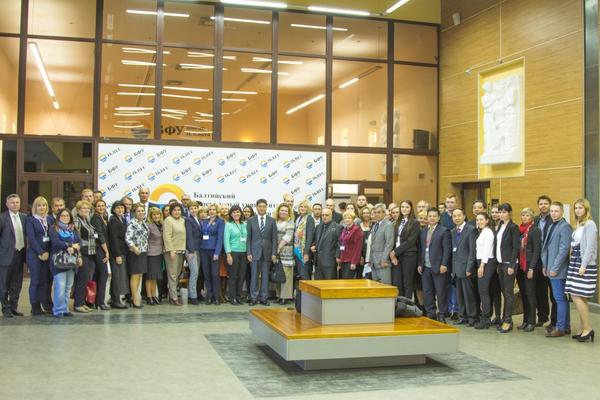
The first Sino-Russian Joint International Accreditation to the Immanuel Kant Baltic Federal University, jointly conducted by HEEC and NCPA.
HEIs gradually perfect their internal governance structure. The government has raised requirements for school governance and self-discipline management of HEIs by law while streamlining administration and delegating power. It is required in the Notice of the Ministry of Education on Issuing the Implementing Outline for University Management by Law that all HEIs should complete the formulation of their articles of association by 2015. Also, it is emphasized that these articles should focus on key tasks of quality improvement, illustrate the principles and systems for guarantee and improvement of education quality, specify the basic rules for HEIs’ evaluation and assessment of disciplines, majors, curricula, a teaching and scientific research level and quality and build a scientific and regulated quality assurance system and evaluation system. In order to further promote the preparation of the articles of association for the HEIs directly under the Ministry of Education and those under other ministries and com-missions of the central government, accelerate the speed of modern university system building, the Ministry of Education also formulated the Action Plan for Preparation of Articles of Association for HEIs Directly Under the Ministries and Commissions of the Central Government (2013-2015). It is required that “by the end of 2015, 114 HEIs directly under the Ministry of Education and central authorities shall complete and approve their articles of association.”
The further facilitation of separation of administration, management and evaluation causes the government to decentralize from administration, education and evaluation, makes the government, HEIs and the society return to their positions, fulfill their responsibilities, make decisions, implement and supervise, and create a new pattern for public governance that is mutually constraint and supportive. Also, public governance has broken the monopoly status of the government’s provision of public goods and services, allowed private enterprise and social groups to get involved in service completion and further facilitate the separation of administration, management and evaluation.
Building a national higher education quality monitoring and evaluation system. From 1994 to 2008, four rounds of institutional evaluation have been conducted in China, during which more than 1,000 institutions were evaluated. In October 2011 the Ministry of Education promulgated the Opinions on Quality Evaluation of Regular Higher Education Institutions, which clearly puts forward that “an evaluation system that is based on self-evaluation of HEIs, taking main contents as institutional evaluation, program accreditation and evaluation, regular monitoring of educational status data, and international evaluation, with the government, HEIs, professional QA agencies, industry and other stakeholders involved shall be established,” which is hereinafter referred to as “five-in-one” evaluation system (see Figure 1).

This stratified and categorized “five-in-one” evaluation system was established corresponding to new challenges and requirements for the increasingly diversified HE system. It combines self-evaluation of higher education institutions, institutional evaluation (including eligibility evaluation and audit), program accreditation, regular monitoring of educational quality data, and international evaluation. Among them, the obligatory institutional evaluation organized by government-authorized quality assurance agencies is the core component. Different from any single evaluation, “five-in-one” evaluation system is no more a one-time evaluation action, but a top-design and a crucial component of the quality assurance system in China, featuring the involvement of multi-stakeholders (HEIs, the government, QA bodies, students, employers) and adopting multiple approaches including monitoring, evaluation, audit and accreditation for quality assurance.
The roles and responsibilities of different stakeholders in our QA system are as follows. The institutions are responsible for setting up an internal QA system and undertaking self study and assessment, based on which they release quality information to the public, and provide foundation for periodic external evaluation or audit. It’s the government’s responsibility to create the National QA Framework and Standards, promulgate policies on quality assurance, and support the external and internal QA activities carried out by QA agencies and by institutions. Great emphasis is laid on the in-depth involvement of profession and industry to the QA system, encouraging accrediting bodies which represent “profession” to conduct the program accreditation in engineering and medicine; jointly developing practice-oriented and hands-on courses or programs with educators; participating in the QA process as evaluators, etc. The QA agencies are supposed to conduct mandatory institutional evaluation / audit, and voluntary program evaluation of HEIs; monitor the educational quality through the National Database; develop an evaluator pool and provide training and capacity building opportunities to them; provide consultation services for policy-makers, HEIs & relative stakeholders. Moreover, this system also engages the high-level overseas evaluators and leading QA agencies, who take part in the international evaluation/accreditation in accordance with the internationally recognized standards and procedures.
1) Self Evaluation: HEIs autonomously set up the internal quality assurance system and undertake self study and assessment, based on which they release quality reports to the public and provide foundation for external evaluation.
2) Institutional Evaluation: the categorized evaluation at the institutional level conducted by QA agencies within the statutory mandate of the government, including eligibility evaluation and audit aiming to guide the HEIs to establish a proper standing and orientation and develop distinctive features. Eligibility Evaluation: Officially launched in 2011, it mainly aims at about 600 HEIs newly established upon approval since 2000. Conformity evaluation takes the national standards and requirements as “basic scale”, puts emphasis on checking the basic school-running conditions, teaching management and teaching quality of higher education institutions and guides higher education institutions to cultivate applied talents for the local development of economy and society. Audit: Officially launched in 2014, it mainly aims at about 650 general four-year higher education institutions that have participated in and passed teaching evaluation. The auditing evaluation emphasizes that schools should “make measurements based on their own standards,” focuses on the fitness for educational purposes, the responsiveness to public demands, the supportability of faculty and educational resources, the effectiveness of quality assurance system, and the satisfaction of students and employers with the purpose of cultivating academic, complex and diversified talents for the national science and technology innovation and economic upgrade.
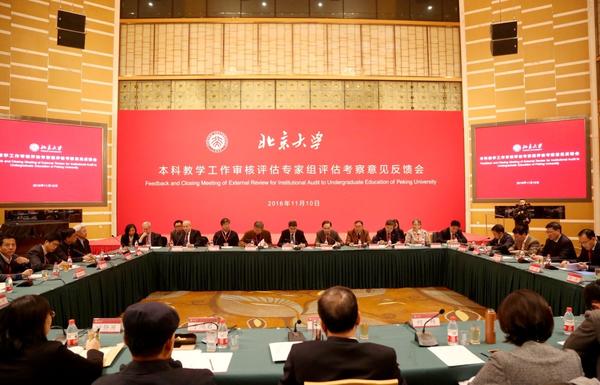
The Feedback and Closing Meeting of the HEEC Institutional Evaluation to Peking University.
3) Program Accreditation: the accreditation and evaluation at the programmatic level carried out by accrediting bodies which represent “the profession” aiming to promote the industry’s in-depth involvement in professional education, and increase the fitness of student training for social demand. We implement the three-level program accreditation mechanism based on the National Data Platform. The first level is Accreditation against the Threshold Standard. The second level is Accreditation against the National Eligibility Standard. The third level is Accreditation against the International Substantial Equivalent Standard. The program accreditation covers almost all the study fields, including Engineering, Medicine, Humanities and Social Science, Natural Science and Agriculture. Particularly in Engineering, in June 2016 China became a full signatory of Washington Accord with unanimous acceptance, which will provide the international recognized “Quality Certificate” for Chinese engineering students.
4) Regular Monitoring of Educational Data: the quality monitoring based on the National Data Platform for Regular Quality Monitoring in Higher Education which covers tertiary vocational, undergraduate and postgraduate education, and contains seven categories of data (78 forms and 674 Data Points), including Educational Resources, Programs & Courses, Faculty, Teaching & Learning, Students, Teaching Management and Quality Management & Monitoring. Data are collected from over 1200 HEIs nationwide; releasing the core data of HEI’s educational status and publishing the National Reports on Quality Monitoring and Evaluation (blue papers).
5) International Evaluation: the evaluations implemented in accordance with international standards and procedures by high-level overseas evaluators or international QA agencies, with the purpose of facilitating the building of world-class universities and disciplines. For example, over 100 engineering programs covering electronic engineering, industrial engineering, chemical engineering, etc. of Tsinghua University, Tianjin University, East China Institute of Technology, etc. have obtained the ABET, IChemE, CTI, ASIIN and EUR-ACE accreditation. More than 20 business schools in China have obtained the three most authoritative accreditation of international business schools, including AMBA, AACSB and EQUIS.
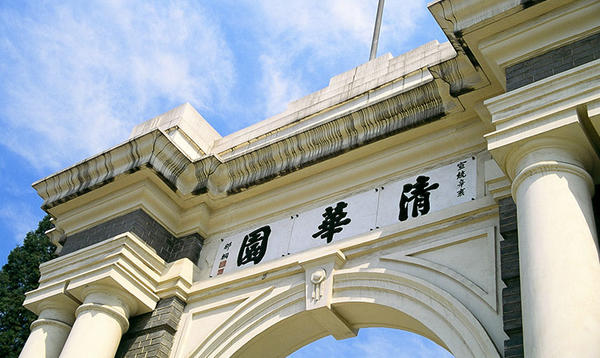
Tsinghua University.
Carol Bobby, the former president of the International Network for Quality Assurance Agencies in Higher Education (INQAAHE) stated that “the concept of schools as subject and student development as orientation,” “categorized evaluation and guidance” adopted in China as well as the practice of “conducting regular quality monitoring and releasing quality reports based on databases” provide good practice cases for higher education quality assurance of the countries with large higher education size.
The status quo of the higher education quality in China
Responsiveness to public demands aims at satisfying the social needs for talents, adapting to economic transformation and growth, and guiding creative ability.
China’s higher education has the largest scale in the world and provides strong support for society in manpower and intelligence. Since the start of the new century China’s higher education has witnessed a great-leap-forward development. As of 2016 China has 36.99 million college students (including 26.96 million undergraduate students), ranking top of the world; 2,880 higher education institutions, ranking the second place; the gross enrollment ratio reaches 42.7%, which is 5% higher than the global average level. The strong desire of the public for receiving higher education was greatly satisfied and tens of millions of senior specialists were trained for all walks of life, which greatly improves the development of China’s human resources.
China’s higher education experiences adjustment of layout and optimization of the specialty and program structure which is basically kept consistent with social and economic growth. Local new HEIs rise swiftly to prominence: HEIs in the middle and west region of China witness a significant increase and higher vocational colleges occupy half of all Chinese HEIs, which are essentially changing the pattern of China’s higher education. The disciplines and programs of HEIs tend to be rational in adjustment and link closer with the industry structure, which greatly satisfies the demand for rapid social and economic growth and industry structure transformation and upgrading.
China’s higher education witnesses gradual improvement in become an important frontier for the national innovation system development. HEIs maintain their absolute advantage in fundamental research and high level in the absolute quantity of scientific and technological achievements. Technological innovation platform series greatly improve technological innovation capacity. And HEIs become contributors of almost 70% of the three prizes for scientific and technological papers and monographs.
China experiences vigorous growth in philosophy and social science and HEIs become leaders in cultural heritage and innovation. HEIs become an important platform for pushing cultural heritage and innovation and national think tank building. Confucius institutes actively promote the diffusion of Chinese excellent culture during the new stage and play a significant role in enhancing the “soft power” of national culture and improving the international competitiveness and influence of China’s higher education.
The top-level talents and endogenous strength of innovation of HEIs are not enough and the support and innovation guidance on the national strategic development is insufficient. Seen from the implementation of national development strategies, HEIs face the following serious problems: insufficient talent training, lack of top-level talents and creative teams, weak transformation of scientific research achievement into productivity, poor integrated creativity of scientific research activities and ineffective mechanisms. Also, HEIs are not playing a leading role in creativity as sources and engines for the national social and economic development.
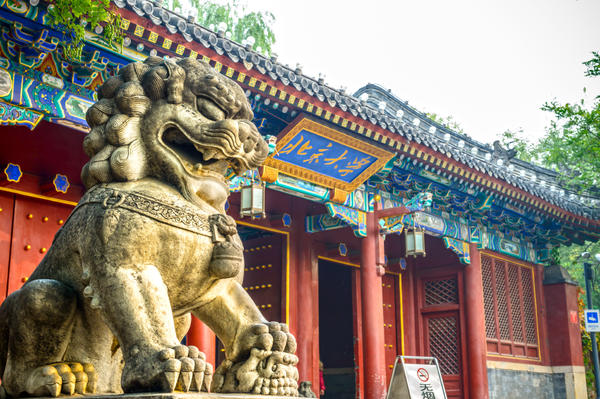
Peking University.
Fitness for educational purposes is attained through training diversified talents in different levels and types, improving the all-round qualities of students.
Various types of HEIs transfer to rational position focused on distinctive development and contributing to a new pattern for diversified student training. Focusing on “training target” HEIs have actively adapted to the demand of socioeconomic development for diversified talents, found out proper school-running orientation that suited local circumstances, formed their own features and characteristics, set the standards for talent training in a practical way, fulfilled their responsibilities, cultivated innovative, interdisciplinary practice-oriented and skills-based talents, changed the homogeneous character in the previous school-running objectives of HEIs and initially built a HEI categorization system with Chinese characteristics.
Major breakthrough and achievements have been made in university-enterprise cooperation and industry collaboration in talent training. Focusing on the “training target” China has issued major comprehensive reform plans, intensively promoted HEIs to gradually update talent training mechanisms and training patterns, made great achievements in a series of actions including university-enterprise cooperation and industry collaboration (including “Top-Notch Talents” and five “Excellent Talents”) and initial achievements in joint and collaborative talent training both inside and outside HEIs.
Various types of HEIs have insisted on talent training by moral education and emphasized all-round development in morality, intelligence, physique and aesthetics. By focusing on the fundamental task of talent training by moral education, HEIs have practiced core socialist values. Students have achieved satisfactory results in technological innovation and social practice. Diversified types of sports activities have effectively changed the trend of students’ poor physical condition. The prevalence of elegant arts on campus have improved the aesthetic sense and spiritual outlook of students and improved their social and occupational adaptability.
HEIs are deficient in innovation and entrepreneurship education and should be alert to the “short planks” of talent training. HEIs have started to pay attention to innovation and entrepreneurship education but lacked systematic support and transformation platforms for technology outcomes. A long-lasting mechanism supporting the innovation and entrepreneurship education has not taken shape yet. There is shortage of practical measurements to promote “mass innovation and entrepreneurship.” Although HEIs have kept a high graduation rate and a degree conferring rate, some HEIs have lowered the requirements for graduation to different extent and some graduates are unable to apply what they have learned in practice, which should be given enough alertness to.
Supportability of educational resources—educational expenditure and campus facilities have greatly improved, faculty team building gets significant achievements.
China’s higher education investment has witnessed a rapid growth, and facilities of HEIs has taken on a new look. In 2014, in comparison with 2004, the educational funds income of HEIs increased by 3.6 times, including an increase in national financial educational funds by nearly five times. From 2010 to 2014, the total value of fixed assets at HEIs has increased by 42.15%; the total value of teaching and research equipment by 57% and the funding for each student reached the peak in history. Various types of HEIs have witnessed a great increase in terms of facilities. The infrastructure of HEIs have obtained complete improvement, from school-running conditions to campus environment and from teaching resources to research facilities; and the information technology level has significantly improved, which can satisfy the demand for teaching and scientific research and provide strong support for full improvement of higher education quality.
The faculty team of HEIs have continuously expanded, hierarchal structure continuously optimized and young teachers enjoyed a huge development potential. From 2000 to 2014 the number of teaching and administrative staff at HEIs increased from 1,065,000 to 2,336,000, making China rank the top in the world, including an increase in the number of full-time teachers from 426,000 to 1,535,000, with a net increase of 1,109,000. 50% of the full-time teachers have obtained master or doctor degrees, and 70% of the young and middle-aged teachers have the degrees. The faculty team of HEIs has witnessed a good trend and faculty team enjoyed a huge development potential and strong support.
Funding for each student is insufficient, student-teacher ratio is high and leading faculty at the master level are lacking in HEIs. There is a gap in the funding per student between different types of HEIs. A lot of newly-built HEIs have not reached the national standards (approx. 2,000 USD per student). Generally, HEIs have the problems of insufficient teaching funds and shortage of experimental and practical teaching. Also, according to the percentage of educational expenditure of HEIs over total national educational expenditure, the percentage of educational expenditure at HEIs in the previous two years witnessed a slight decrease. The student-teacher ratio is slightly higher, with about 80% teachers holding junior and intermediate professional titles. There is a lack of leading talents and discipline leaders at the master level. Thus, it is a typical problem to realize the new leap of changes from quantity to quality.
Satisfaction of students and employers is achieved by showing more concern about students, with continuous improvement in satisfaction of students and employers.
Students are more satisfied with “hardware” resources than “software” resources, faculty quality than education quality of HEIs. HEIs have improved their teaching and living environment by increasing input and system guarantee such as funds, personnel and resources. Students’ learning and living experience satisfaction has gradually improved.
HEIs focus on students’ development and show more concern about talent training. HEIs strive to show concern towards students and enhance student employment. Students are generally satisfied with learning experience and employment status but different types of HEIs are imbalanced. In the Project 985 and Project 211 universities students’ recognition of teachers’ academic level is obviously higher than their teaching level. While in terms of recognition of education quality, the Project 985 and Project 211 universities are lower than common HEIs.
The graduation rate of HEI stays at a high level, with small percentage in students creativity and entrepreneurship. The employment rate varies among HEIs. The Project 985 and Project 211 universities are better than common HEIs in terms of the graduation rate. Only a small percentage of students pursue creativity, and students’ comprehensive ability needs to be enhanced, especially that of master students.
Employers generally recognize the quality of graduates and there is a large variability in different types of HEIs. The knowledge, ability and quality of students are recognized by the industry; however, there is a gap between HEI teaching and social practice and there is not enough correlation between the programs of graduates and their jobs. It is required that we should further enhance the training of creative talents, improve students’ practice and entrepreneurship and pay attention to employers evaluation results to adjust program setting and talent training policies.
The Higher Education Evaluation Center (HEEC), established in August 2004, is a public body with statutory mandate under the aus-pices of the Ministry of Education, China. HEEC is the national author-ity for higher education quality assurance, with the responsibility of providing multi-level evaluation, accreditation, regular educational quality monitoring and consultation services nationwide.
HEEC’s Mission
Guard the national education quality, provide professional evalua-tion service to higher education sectors.
HEEC’s Main Functions
- Conduct the institutional quality evaluation/audit to HEIs;
- Conduct the program/specialized accreditation to HEIs;
- Develop and maintain the National Data Platform for Educational Quality Monitoring;
- Create and publish the Annual National Quality Monitoring Report Series;
- Offer training sessions and workshops to reviewers, HEIs and QA agencies;
- Develop exchanges, cooperation and partnerships with overseas QA agencies and international organizations;
- Carry out research and provide counseling and consultation ser-vices on quality assurance.
HEEC's International Engagement & Cooperation in QA Activities
Aiming to listen and think globally, to keep up with the latest trend of QA, to increase the influence of Chinese higher education through international engagement and cooperation.
- Memorandums of Understanding with quality assuarance agencies from Russia (Rosobrnadzor, NAA and NCPA), the US, Australia, the UK, Germany, etc.
- Full membership in INQAAHE and APQN.
- Cooperation with UNESCO/IIEP in IQA Projects and organization of relative international conferences.
- Cooperation with the European Union in the promotion of U-Multitrank in China.
- Representing China to introduce the QA system in China-EU High Level People-to-People Dialogue (HPPD).
- CAMPUS Asia Quality Evaluation and Monitoring in collaboration with NIAD-QE, Japan, and KCUE, Korea.
- Joint International Accreditation of Russian and Chinese universi-ties in compliance with the common quality standards jointly developed by HEEC and NCPA.
- Institutional or program evaluation with the engagement of inter-national expertise (high-level oversea evaluators or reviewers).